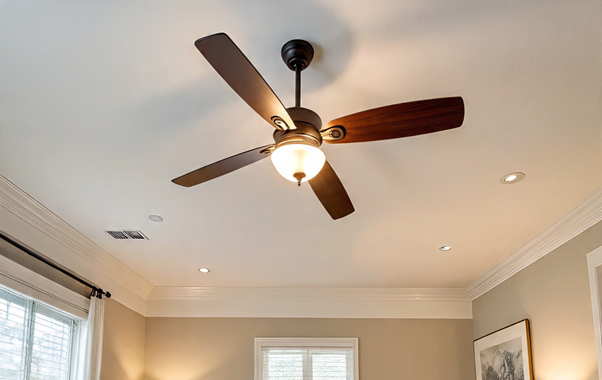When it comes to feeling cool and comfortable in one’s room even on hot days, ceiling fans are one of the best energy efficient choices. But buying the right fan isn’t just about style or brand selection; it’s also about placing it at the right height. The performance, airflow and room cooling depends on the height it is placed at.
Why Ceiling Fan Height Matters
The airflow efficiency is dependent on the ceiling fan height how the fan is positioned in relation to the ceiling and floor. If a ceiling fan is installed too close to the ceiling, airflow is limited and circulation is reduced. If it is hung too low, however, it can become a safety hazard as well as create a distracting breeze at head height. It is recommended to have 8 to 9 feet of space between the floor and the blades of the fan. For an average 8-feet ceiling, a flush mount fan is ideal and is best suited for tight spaces. For ceilings higher than 9 feet, a downrod of about 6-inch to 12-inch must be used to bring the ceiling fans down to the best operating height. For ceilings of height of 11 feet and higher, make use of longer downrods of 18 inches to get the fan running at an optimal height.
Always keep in mind that fan blades must be a minimum of 7 feet above the floor for safety, and preferably 10 to 12 inches from the ceiling for optimal air movement.
Sloped or Vaulted Ceilings
In areas where ceiling slopes or vaults, mounting the fan properly calls for an angle-compatible ceiling fan or a ceiling adapter for angled ceilings. Ensure that the fan is hung straight down, make use of a longer downrod to set the blades at the proper height. The best ceiling fans can handle slopes of 15 degrees, even 30 degrees.
Selecting the Proper Size
Although height matters, blade span also matters. A bigger room will require a fan with a greater diameter to provide sufficient air movement. For instance, a 52-inch fan is effective for average to big rooms, but a 60-inch or bigger fan would be better for open-plan spaces or big living rooms. Complementing the right blade size with proper mounting height ensures the fan operates effectively, providing equal distribution without stressing the motor.
The effectiveness of ceiling fans goes beyond aesthetics and brand. Installing your fan at the right height ensures better airflow, energy savings, and improved comfort throughout the year. Whether you’re looking to fix fans at the right height in a compact bedroom or a high-ceilinged hall, adjusting the fan height according to your ceiling type and room dimensions is key. Even the best ceiling fans do not perform at its best if not fitted at proper height according to the room size. So take some time and effort to first evaluate the ceiling height, decide the apt length of downrod required to provide desired cool air in the space. Brands like Orpat also offer a range of fan models suited for different ceiling types and heights, making installation more efficient and reliable

